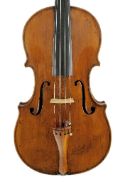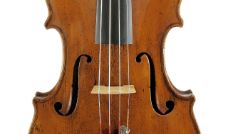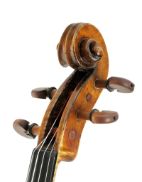Viola, Giovanni Battista Guadagnini, Turin, 1784
Printed label: “JO. BAPT. GUADAGNINI / Cremonensis alumnus / ANTONII STRADIVARI / fecit Taurini 1784 [cross as well as the initials GBG T]” (1784 handwritten)Until about 1700, violins, violas and violoncellos were built in different sizes. The difference between the large and small violin models was not very big, only a few millimeters, but the body lengths of violas and violoncellos often diverged by several centimeters. The instruments were ideally suited to playing Baroque music with its limited technical demands. However, once virtuous solo parts and more difficult chamber music had been written, the excessively large violas and violoncellos were found to be impractical, and smaller body models prevailed. This change is easy to see in the development of Stradivari’s work: From about 1690, Stradivari evolved a smaller viola model usually known as the contralto model. Guadagnini’s viola from 1784 corresponds to this model and is fairly short with a body length of 40 cm. Yet the viola is sonorous and is especially well suited to playing chamber music. This instrument is a typical example of Guadagnini’s late period in Turin. The model is short and broad with a flat arch. Stradivari’s influence shows in the scroll and f-hole design as well as the edgework. The divided belly is fine-grained in the middle, with the annual rings becoming wider toward the edges. A dendrochronological report dated the latest annual ring to 1769, and the two halves of the belly are from the same log. The dating of the belly wood corroborates the period in which the instrument was built. The instrument shows a high correlation with other instruments made by Guadagnini. The maple wood of the back is quarter cut , and the faint flames slope downward slightly toward the edges. The ribs are also quarter cut and have the same structure as the wood of the back. The arching is flat, with the back arched higher than the belly. The shape and fluting style of the lower f-hole wings is reminiscent of Stradivari’s style. The viola has very small upper eyes. Its scroll was somewhat hastily carved overall and looks very powerful. The contours are highlighted by wide, blackened chamfers. The appearance of the instrument is dominated by a luminous orange-red varnish that is still largely intact.






